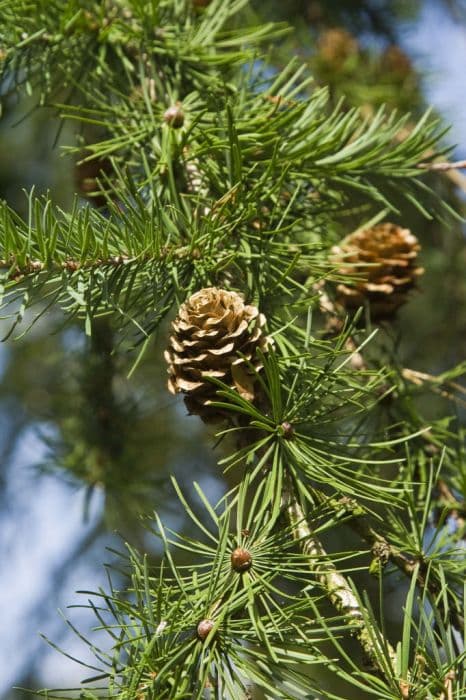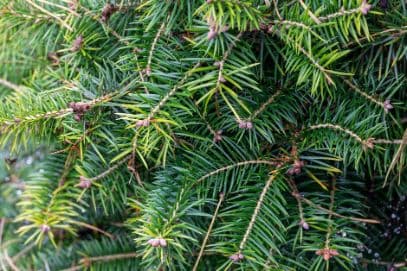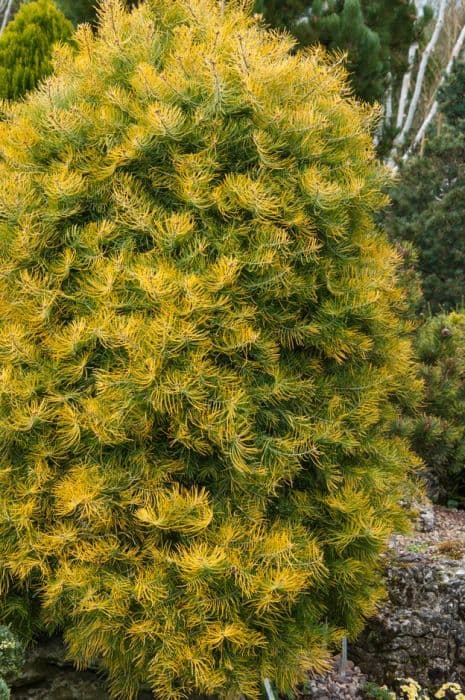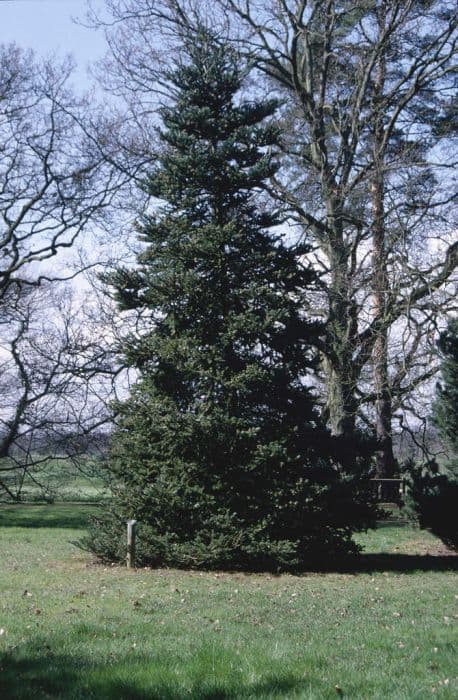Japanese larch Larix kaempferi

ABOUT
The Japanese larch is a coniferous tree that is deciduous, which means it sheds its needles annually. Its needles are soft to the touch and light green in color, changing to a beautiful golden-yellow before they fall in the autumn. The needles are arranged in clusters, or tufts, attached to short shoots, giving the branches a somewhat bushy appearance. The bark of the Japanese larch is initially smooth and gray when the tree is young. As it matures, the bark becomes rough and fissured, displaying a reddish-brown color. The tree's overall shape is conical, with a straight trunk and a crown that becomes more open and broad as the tree ages. Its cones are small and oval-shaped, starting out green and turning to a woody brown as they mature. Typically, the cones are arranged upright on the branches. These cones are not overly large, adding a delicate ornamental appeal to the tree. In the spring, the Japanese larch produces new shoots that are noticeably lighter in color. These shoots stand out against the older, darker wood, adding to the visual interest of the tree. The contrast between the fresh spring growth and the mature foliage creates a charming effect that is admired by many gardeners and tree enthusiasts. Despite being a larch, which is commonly associated with evergreens, the Japanese larch's needle shedding habit gives it a unique presence in landscapes, offering year-round visual interest through the changes in its foliage and the striking silhouette it casts in the winter.
About this plant
 Names
NamesSynonyms
Japanese Larch, Karamatsu, Japanese Red Pine.
Common names
Abies kaempferi, Abies leptolepis, Larix leptolepis, Pinus kaempferi, Pinus leptolepis.
 Toxicity
ToxicityTo humans
The plant commonly known as Japanese larch (Larix kaempferi) is not generally considered toxic to humans. No significant reports of toxic effects from ingesting any part of the Japanese larch have been documented in the available literature as of my last update. It is generally safe for humans, but as with any non-edible plant, it's advisable not to ingest parts of it as it is not intended for consumption and there could always be a risk of a personal allergic reaction or gastrointestinal discomfort.
To pets
The plant commonly known as Japanese larch (Larix kaempferi) is not known to be toxic to pets. There have been no significant reports of toxicity in animals from ingesting this plant. However, as with any non-edible plant, it's a good practice to prevent pets from ingesting it, since non-food plants can potentially cause mild stomach upset or an allergic reaction in some pets.
 Characteristics
CharacteristicsLife cycle
Perennials
Foliage type
Deciduous
Color of leaves
Green
Height
70 feet [21 meters]
Spread
30 feet [9 meters]
Plant type
Tree
Hardiness zones
5
Native area
Japan
Benefits
 General Benefits
General Benefits- Ornamental Value: Larix kaempferi, commonly known as the Japanese larch, is often used in landscaping and gardens for its aesthetic appeal, particularly its striking golden-yellow foliage in autumn.
- Timber Production: The wood of the Japanese larch is valued for its strength and durability, making it suitable for construction, carpentry, and the production of outdoor structures.
- Reforestation and Soil Stabilization: As a fast-growing tree, it is used in reforestation projects and can help stabilize soil in eroded areas.
- Habitat and Biodiversity: The Japanese larch provides habitat for wildlife, supporting a variety of birds, insects, and small mammals, thus contributing to biodiversity.
- Climate Adaptability: Larix kaempferi is adaptable to a range of climates and is known for being cold-tolerant, making it suitable for northern landscapes and high altitude reforestation.
 Medical Properties
Medical Properties- Anti-inflammatory: Larix kaempferi contains compounds that may reduce inflammation.
- Antimicrobial: Extracts from the tree have been studied for their potential to fight against certain bacteria and fungi.
- Antioxidant: Components like flavonoids in the plant may offer antioxidant benefits.
 Air-purifying Qualities
Air-purifying QualitiesThis plant is not specifically known for air purifying qualities.
 Other Uses
Other Uses- Larch wood is often used in the construction of yachts and other small boats due to its durability, resistance to decay, and its ability to bend well without breaking when steamed, which is particularly useful in shipbuilding.
- The wood of Larix kaempferi is ideal for making musical instruments such as soundboards for guitars and violins, as it provides good acoustic properties and a fine, clear tone.
- In landscaping, Larix kaempferi is valued for its aesthetic appeal, especially in the autumn when its needles turn a golden yellow before dropping, providing a striking visual display for gardens and parks.
- Japanese larch is sometimes used in bonsai cultivation, where its characteristic bark and conical shape can be manipulated into artful miniature trees.
- The resin extracted from the larch tree is used in the manufacture of varnishes and paints, providing a high-quality natural binding agent for pigments.
- Larix kaempferi sawdust and wood chips can be utilized as a natural mulch in gardens to conserve soil moisture and control weeds, while also providing an aesthetic ground cover.
- The timber of Japanese larch is often used for outdoor construction projects like decking, fencing, and cladding due to its natural resistance to rot and its longevity in weather-exposed conditions.
- Due to its straight grain and uniform texture, Japanese larch wood is popular in woodworking for creating furniture, paneling, and flooring, as it holds finishes well and can be stained to resemble more expensive woods.
- Japanese larch needles, which are rich in vitamin C, have been traditionally used in some cultures to make a herbal tea that is believed to have health-benefiting qualities.
- The decorative cones of Larix kaempferi can be used in floral arrangements and as components of natural craft projects, providing texture and a rustic feel.
Interesting Facts
 Feng Shui
Feng ShuiThe Japanese Larch is not used in Feng Shui practice.
 Zodiac Sign Compitability
Zodiac Sign CompitabilityThe Japanese Larch is not used in astrology practice.
 Plant Symbolism
Plant Symbolism- Resilience: The Japanese larch, like many coniferous trees, can withstand cold climates and poor soil conditions, symbolizing the ability to persist through adversity.
- Renewal: As a deciduous conifer that sheds its needles in the fall, the Japanese larch represents the cycle of renewal and the idea that one can start anew after a period of loss or dormancy.
- Strength: It's a robust tree with a sturdy trunk, often representing inner strength and the ability to stand firm against challenges.
- Hope: The bright green foliage in spring after a bare winter symbolizes hope and the promise of new growth and opportunities.
- Transformation: The seasonal change from green to golden needles before they are shed represents transformation and the beauty of change.
 Water
WaterThe Japanese Larch, as Larix kaempferi is commonly known, requires regular watering, especially during its growing season in spring and summer. It prefers evenly moist soil, so it’s important to water it when the top inch of soil feels dry. Depending on the climate and weather conditions, this can mean watering every couple of days or once a week. As a general rule, providing 1 to 2 gallons of water weekly should be sufficient, but this may vary depending on temperature and soil drainage. Always ensure adequate drainage to prevent waterlogging, as the Japanese Larch does not tolerate standing water.
 Light
LightThe Japanese Larch thrives in full sun to partial shade. It performs best when it receives at least 6 hours of direct sunlight daily. This tree is ideally planted in an area where it can receive unfiltered sunlight throughout the day. Avoid deeply shaded areas, as this can inhibit its growth and affect needle development.
 Temperature
TemperatureFor the Japanese Larch, the ideal temperatures for growth range between 60°F and 70°F. It is hardy and can withstand winter temperatures down to -30°F, while in summer, it can tolerate temperatures up to 90°F without any adverse effects. It is important to note that the Japanese Larch requires a period of cold dormancy, so winter conditions are actually beneficial for this tree's health and growth cycle.
 Pruning
PruningPruning the Japanese Larch is generally done to remove damaged or diseased branches and to shape the tree for aesthetic purposes or to maintain size. The best time to prune is in late winter or early spring before the new growth begins. Pruning can be performed annually, but it's often not necessary to prune every year unless shaping is desired or maintenance is needed for damaged branches.
 Cleaning
CleaningAs needed
 Soil
SoilThe best soil mix for the Japanese Larch should be well-drained, with a slightly acidic to neutral pH, between 5.5 and 7.0. A blend of loam, sand, and peat is ideal to accommodate its roots and replicate its natural habitat conditions.
 Repotting
RepottingJapanese Larches growing in containers should be repotted every two to three years to avoid root binding and replenish nutrients in the soil.
 Humidity & Misting
Humidity & MistingJapanese Larch prefers moderate humidity levels but is adaptable to a variety of humidity conditions as long as proper soil moisture is maintained.
 Suitable locations
Suitable locationsIndoor
Grow Japanese Larch indoors with ample light; rotate for even growth.
Outdoor
Plant Japanese Larch in full sun, well-draining soil, and space adequately.
Hardiness zone
4-7 USDA
 Life cycle
Life cycleJapanese larch (Larix kaempferi) begins its life cycle as a seed that requires a period of cold stratification to germinate effectively. Upon germination in the spring, the seedling develops a root system and a shoot that enable it to grow into a young sapling, adapted to survive in cool temperate climates. As it matures, the Japanese larch undergoes a period of vegetative growth, characterized by the development of needle-like leaves in the spring, which it later sheds in the fall, making it a deciduous conifer. After reaching maturity, which can take several years, it produces cones; the female cones are small and grow upright on the branches, while male cones release pollen that fertilizes the female cones. Following fertilization, seeds develop within the cones and are eventually dispersed by wind or animals, allowing the plant to reproduce and complete its reproductive cycle. Over many years, the Japanese larch can grow into a large tree reaching heights of up to 70 feet or more, with a lifecycle that can span over a century.
 Propogation
PropogationPropogation time
Spring to early summer
Propogation: The Japanese larch, known scientifically as Larix kaempferi, is a coniferous tree that is commonly propagated through seed sowing. The most popular method of propagation is the sowing of seeds in the spring after they have been stratified, which is a cold treatment that simulates winter conditions, helping to break the seed's dormancy. Stratification involves mixing seeds with moist sand and refrigerating them at about 34 to 41 degrees Fahrenheit (1 to 5 degrees Celsius) for approximately 1 to 2 months. After stratification, seeds are sown in well-drained soil and lightly covered with soil. The seedbeds are kept moist until germination, which typically occurs in the spring. This method is favored as it often results in robust seedlings that can be transplanted to their permanent location within a few years.









